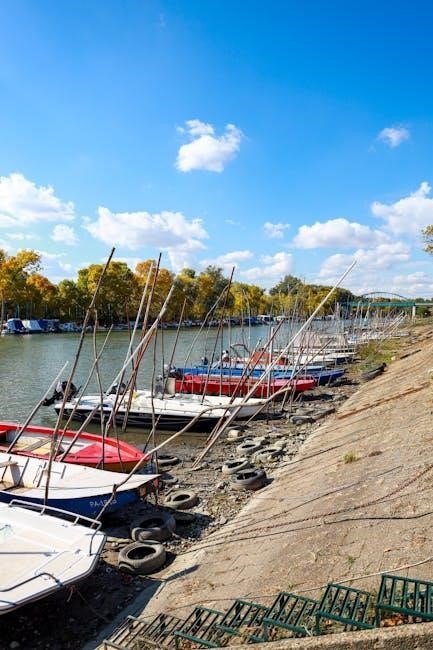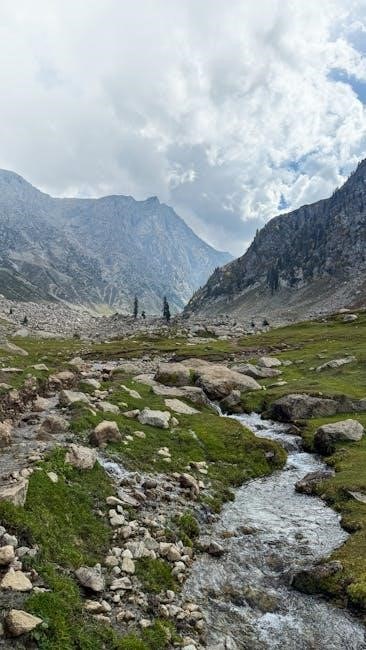the river gary paulsen pdf
Download "The River" by Gary Paulsen PDF for a gripping wilderness adventure. Get your free eBook now and dive into this must-read survival story!
Gary Paulsen, a celebrated author of wilderness survival stories, captivates readers with works like Hatchet, Tracker, and The Haymeadow. His novels explore themes of resilience and nature.
1.1. Gary Paulsen: A Renowned Author of Wilderness Survival Stories
Gary Paulsen is a celebrated author known for his gripping wilderness survival stories. His works, such as Hatchet, Tracker, and The Haymeadow, have captivated readers with their vivid portrayals of resilience and nature. Paulsen’s ability to blend adventure, danger, and self-discovery has made him a favorite among young readers and educators alike. His writing often explores themes of survival, self-reliance, and the human connection with the natural world, earning him a reputation as a master of the genre. His stories are both thrilling and educational, leaving a lasting impact on readers.
1.2. Overview of His Notable Books: Hatchet, Tracker, and The Haymeadow
Gary Paulsen’s notable works include Hatchet, a gripping tale of a boy’s survival with only a hatchet, Tracker, exploring a young hunter’s bond with nature, and The Haymeadow, detailing a teenager’s journey herding cattle. These stories showcase themes of survival, self-reliance, and human connection with the wild. Paulsen’s vivid storytelling and realistic depictions of wilderness challenges have made these books classics in the survival genre. They are now available in PDF and other digital formats, ensuring accessibility for modern readers while preserving their timeless appeal.
1.3. The River as a Sequel to Hatchet
The River serves as a compelling sequel to Hatchet, continuing Brian Robeson’s journey. Two years after his initial wilderness ordeal, Brian is asked to repeat the experience for a scientific study. This time, he faces new psychological and physical challenges, further testing his survival skills. The story deepens Brian’s connection with nature while exploring the emotional scars of his past. Available in PDF format, The River offers readers a seamless continuation of Brian’s saga, maintaining the gripping narrative style that defines Paulsen’s work.

Plot Summary of The River
Brian Robeson returns to the wilderness in The River, facing new challenges as scientists study his survival skills. His journey tests endurance and mental strength, revealing growth.
2.1. Brian Robeson’s Return to the Wilderness
Brian Robeson, profoundly changed by his previous wilderness experience, is asked to return to the wild to help scientists study survival psychology. Two years after his life-altering ordeal in Hatchet, Brian agrees, seeking to prove his skills and resilience. This journey pushes him to confront new physical and mental challenges, testing his ability to adapt and survive. His return to the wilderness is not just a repetition of the past but a deeper exploration of human endurance and growth.
2.2. The Psychological and Physical Challenges Brian Faces
Brian Robeson faces immense psychological and physical challenges in The River. Isolation and the harsh wilderness test his mental resilience, forcing him to confront fear and loneliness. Physically, he battles extreme weather, hunger, and the relentless demands of survival. The weight of his previous ordeal haunts him, yet he draws on past lessons to endure. Brian’s journey is a testament to human resilience, as he grows stronger both in body and spirit, proving his ability to overcome even the most daunting challenges.
2.3. The Role of Scientists in the Story
In The River, scientists play a pivotal role in Brian’s journey, offering guidance and resources that aid his survival; Their expertise provides practical solutions to the challenges Brian faces, such as building shelter and finding food. They also represent a connection to the outside world, contrasting with Brian’s isolated existence. Their presence highlights the interplay between human knowledge and nature, underscoring how understanding the environment can enhance survival skills. This interaction adds depth to the story, emphasizing collaboration between humans and the natural world.
Themes and Symbolism in The River
The River explores themes of survival, self-discovery, and resilience, with the river symbolizing life’s unpredictable journey and Brian’s inner growth. Isolation and nature’s power shape Brian’s psyche, emphasizing harmony with the wild.
3.1. Survival and Self-Reliance in the Wild
In The River, survival and self-reliance are central themes. Brian must adapt to the harsh wilderness, relying on instincts and skills learned from his previous ordeal. The river, a lifeline, provides fish and water but also poses dangers, testing his resilience. Brian’s ability to build shelter, start a fire, and hunt showcases his growth into a capable survivor. The novel underscores the importance of self-sufficiency and mental determination, highlighting how isolation forces individuals to confront their limits and discover inner strength.
3.2. The Psychological Impact of Isolation
In The River, Brian’s prolonged isolation in the wilderness deeply affects his mental state. The silence and solitude amplify his thoughts, creating a mix of loneliness and introspection. He struggles with the weight of his past and the pressure of surviving anew. However, isolation also fosters self-awareness and resilience, as Brian learns to embrace the quiet and find strength within himself. This psychological journey highlights the dual nature of isolation—its challenges and its transformative power.
3.3. The Symbolism of the River and Nature
The river in Gary Paulsen’s The River is a profound symbol of life, change, and resilience. It represents the constant flow of existence, with its unpredictable currents mirroring the ups and downs of human experience. Nature, as depicted in the novel, is both nurturing and unforgiving, serving as a teacher to Brian. The river’s presence underscores themes of survival and self-discovery, while its ever-changing nature reflects the dynamic relationship between humanity and the wild.
Character Development in The River
Brian Robeson evolves significantly, showcasing heightened resilience and maturity. His experiences in the wilderness deepen his understanding of nature and himself, refining his survival instincts and emotional strength.
4.1. Brian Robeson: A Protagonist Transformed by Experience
Brian Robeson undergoes profound transformation in The River, as his wilderness ordeal reshapes his identity. His experiences in the wild foster resilience, self-awareness, and a deeper connection with nature. The challenges he faces—harsh weather, isolation, and survival struggles—test his physical and mental limits, pushing him to grow beyond his previous self. His journey is not just about survival but about understanding life’s essence, making him a stronger, wiser, and more reflective individual. This transformation highlights his ability to adapt and thrive in the face of adversity.
4.2. The Evolution of Brian’s Character from Hatchet to The River
Brian Robeson’s character evolves significantly from Hatchet to The River. In Hatchet, Brian is a young boy struggling with innocence and survival. By The River, he is more experienced, proactive, and emotionally mature. His skills in wilderness survival are refined, and he faces new challenges with confidence. The psychological depth of his character grows as he confronts isolation and learns to rely on himself. This evolution showcases his journey from vulnerability to resilience, highlighting his ability to adapt and grow through adversity.
4.3. Secondary Characters and Their Influence on Brian
In The River, secondary characters like the scientists play a pivotal role in Brian’s journey. They introduce him to new survival techniques and challenges, expanding his knowledge of the wilderness. Their presence adds depth to the story, as Brian learns to trust and rely on others, contrasting with his solitary experience in Hatchet. These interactions highlight Brian’s growth in communication and teamwork, showing how external influences shape his resilience and understanding of nature. Their impact underscores the importance of human connection in survival.

Literary Style and Writing Techniques
Gary Paulsen’s direct, concise prose immerses readers in Brian’s wilderness journey, blending vivid descriptions with introspective dialogue to build tension and emotional depth seamlessly.
5.1. Paulsen’s Direct and Engaging Narrative Style
Gary Paulsen’s writing in The River is characterized by a direct, unembellished prose that captivates readers with its clarity and emotional depth. His narrative style avoids unnecessary complexity, allowing the raw intensity of Brian’s experiences to shine through. Paulsen masterfully balances descriptive language with a fast-paced rhythm, creating a sense of immediacy that draws readers into the wilderness. This approach ensures that the story remains both accessible and compelling, making it easy for young readers to connect with Brian’s journey and the challenges he faces.
5.2. Use of Descriptive Language to Depict the Wilderness
Gary Paulsen employs vivid and evocative language to bring the wilderness to life in The River. His descriptions of the natural world are rich in sensory detail, capturing the sights, sounds, and smells of the forest. From the “sparkling clarity” of the river to the “dense, emerald green” of the trees, Paulsen’s prose immerses readers in Brian’s environment. This descriptive depth not only enhances the story’s realism but also underscores the vastness and beauty of nature, making the wilderness a central character in its own right.
5.3. The Role of Dialogue in Shaping the Story
In The River, dialogue plays a subtle yet significant role in advancing the narrative and revealing character dynamics. Brian’s interactions with the scientists and his brief exchanges with others provide insight into his growing confidence and resourcefulness. The sparse use of dialogue emphasizes Brian’s isolation, while its strategic placement heightens tension and underscores key moments of realization. This minimalist approach allows Paulsen to focus on Brian’s internal journey, using dialogue sparingly to enhance the story’s emotional and psychological depth.

The River in Comparison to Other Works by Gary Paulsen
The River provides a deeper exploration of Brian’s character and more mature themes, offering a unique continuation of his wilderness journey in Paulsen’s works.
6.1. Similarities and Differences with Hatchet
The River shares themes of survival and resilience with Hatchet, but it introduces new challenges and deeper character development. While Hatchet focuses on Brian’s initial isolation, The River explores his growth and interactions with others. Both books emphasize the importance of nature and resourcefulness, but The River delves into more complex emotional and psychological struggles. The sequel builds on the foundation of Hatchet, offering a fresh perspective on Brian’s journey while maintaining Paulsen’s signature vivid storytelling.
6.2. The River vs. Other Brian’s Saga Books
The River stands out in Brian’s Saga for its focus on psychological depth and interpersonal dynamics. Unlike other books, it emphasizes Brian’s interactions with scientists, adding a unique layer to his survival journey. While books like Brian’s Winter and Brian’s Return focus on isolated survival, The River blends external challenges with internal growth, showcasing Brian’s evolving resilience and understanding of nature. This blend of human connection and wilderness survival makes The River a distinctive yet integral part of the series.

6.3. Unique Aspects of The River
The River offers a fresh perspective by introducing scientists, adding depth to Brian’s survival story. Unlike other books in the saga, it explores the intersection of human curiosity and wilderness. The river itself becomes a central character, symbolizing both danger and sustenance. Brian’s psychological journey is more pronounced here, showcasing his growth in understanding nature. The blend of survival techniques, emotional struggles, and external influences makes The River a compelling and distinctive addition to Brian’s Saga, highlighting Paulsen’s ability to innovate within his signature themes.
The Significance of the Title: The River
The river, a central element, symbolizes life’s journey, driving Brian’s survival and personal growth, while serving as a dynamic and essential force in the story.
7.1. The River as a Central Element of the Story
The river is the heartbeat of the narrative, shaping Brian’s journey and the story’s progression. It serves as both a challenge and a lifeline, influencing his decisions and survival strategies. The river’s constant presence underscores its importance, symbolizing the ever-changing nature of life. Its role in providing resources and creating obstacles highlights its dual impact on Brian’s existence. The river’s significance is further amplified by its depiction in the PDF version of The River, where its vivid description enhances the reading experience, making it a central focus of the story.

7.2. The River’s Role in Brian’s Survival
The river is pivotal to Brian’s survival, providing water, food, and transportation. It teaches him patience and the importance of adapting to nature. The river’s resources, like fish and plants, sustain him, while its dangers, such as the tornado, test his resilience. In the PDF version of The River, the river’s dual role as a lifeline and a challenge is vividly portrayed, emphasizing its crucial impact on Brian’s journey and growth. This duality underscores the river’s essential role in his survival and personal development.

7.3. The River as a Metaphor for Life
The river in Gary Paulsen’s The River serves as a profound metaphor for life. Like the river’s constant flow, life is unpredictable and ever-changing. The river’s tranquility and fury mirror life’s calm moments and turbulent challenges. Brian’s journey along the river symbolizes personal growth, resilience, and the inevitability of change. The PDF version of The River highlights how the river’s relentless movement reflects life’s journey, teaching Brian—and readers—to adapt, persevere, and find meaning in the natural world’s rhythms. This metaphor enriches the story’s depth and universal appeal.
Why Read The River?
The River captivates readers with its gripping wilderness survival story, continuing Brian Robeson’s journey. It offers insights into resilience, self-reliance, and personal growth, making it a compelling read for adventure lovers. The PDF version ensures accessibility across devices, enhancing the reading experience for fans of Gary Paulsen’s work.
8.1. Appeals to Fans of Wilderness Survival Stories
The River captivates fans of wilderness survival stories with its thrilling narrative of Brian Robeson’s return to the wild. The novel delivers intense action, emotional depth, and practical survival techniques, making it a must-read for enthusiasts of the genre. Paulsen’s vivid descriptions of nature and Brian’s challenges create an immersive experience. The PDF version of The River ensures easy access to this gripping tale, allowing readers to dive into Brian’s journey anywhere, anytime, while maintaining the story’s original intensity and charm.
8.2. The Book’s Relevance to Young Adult Readers
The River resonates deeply with young adult readers, offering a compelling story of resilience and growth. Brian’s journey mirrors the challenges of adolescence, such as self-discovery and overcoming fears. The novel’s themes of perseverance and adaptability inspire young readers to confront their own struggles. Additionally, the PDF format makes the book accessible on various devices, allowing teens to engage with Brian’s transformative experience anytime, fostering a connection with wilderness survival and personal growth in a modern, convenient way.
8.3. The Educational Value of the Novel
The River offers significant educational value, teaching survival skills, environmental awareness, and life lessons. It encourages critical thinking about nature and self-reliance, making it a valuable resource for curriculum use. The PDF format allows educators to easily integrate the novel into lesson plans, promoting discussions on resilience, adaptation, and the human relationship with the wilderness. Its relatable themes and vivid storytelling help students connect with literature while learning essential life skills in an engaging way.

The River in PDF Format
The River by Gary Paulsen is widely available in PDF format, accessible via online bookstores and libraries, offering a convenient reading experience on multiple devices.
9.1. Availability of The River in Digital Formats
The River by Gary Paulsen is readily available in digital formats, including PDF, through popular platforms like Amazon, Barnes & Noble, and Google Books. Many libraries also offer it via OverDrive or similar services. The PDF version ensures compatibility with e-readers, tablets, and smartphones, making it accessible to a wide audience. This format is ideal for readers seeking convenience and portability, allowing them to enjoy the story anywhere. The digital release has expanded the book’s reach, catering to modern reading preferences.
9.2. Benefits of Reading The River in PDF
Reading The River in PDF offers several advantages. The digital format allows for easy navigation, with features like bookmarking and search functions. PDFs maintain the original layout, ensuring a clean reading experience. Additionally, PDFs are space-saving and environmentally friendly compared to physical copies. The ability to adjust font size enhances readability on various devices. Furthermore, PDF versions are often cost-effective and readily accessible, making Gary Paulsen’s compelling story more convenient for readers worldwide.
9.3. Compatibility with Various Devices
The PDF format of The River ensures compatibility across a wide range of devices, including smartphones, tablets, e-readers, and computers. This versatility allows readers to access the story anywhere, maintaining consistent formatting and readability. Whether on a smartphone during commutes or a tablet at home, the PDF adapts seamlessly to different screens. This accessibility makes it convenient for readers to enjoy Gary Paulsen’s vivid storytelling in their preferred environment, enhancing the overall reading experience.
The River remains a timeless tale of survival and self-discovery, with its PDF format ensuring accessibility and enduring relevance in Gary Paulsen’s literary legacy.
10.1. The Lasting Impact of The River
Gary Paulsen’s The River leaves a profound impact, resonating with readers through its vivid portrayal of survival and self-discovery. Its themes of resilience and nature’s power continue to captivate audiences, making it a cornerstone of wilderness literature. The novel’s ability to blend psychological depth with thrilling adventure ensures its relevance across generations. As a PDF, it remains accessible, allowing readers to explore Brian’s journey in a convenient format, further cementing its place as a timeless classic in young adult literature.
10.2. Gary Paulsen’s Legacy in Wilderness Literature
Gary Paulsen’s legacy in wilderness literature is unparalleled, with works like The River solidifying his reputation as a master of survival storytelling. His ability to weave raw adventure with profound introspection has inspired countless readers and writers. Paulsen’s themes of resilience, nature, and self-discovery continue to resonate, ensuring his stories remain timeless. The availability of his books, including The River in PDF, ensures his legacy endures, introducing new generations to the beauty and brutality of the wild.
10.3. Final Thoughts on The River
‘, and I need to write exactly for it. Plus, I have to make sure I don’t include any information that’s covered in other subheadings;
First, I need to recall what The River is about. It’s a sequel to Hatchet, where Brian Robeson returns to the wilderness. The story focuses on his survival, psychological challenges, and interactions with scientists. The themes include survival, self-reliance, isolation, and nature symbolism. The title itself, The River, is symbolic, representing both a physical and metaphorical journey.
Since this is the final thoughts section, I should wrap up the article by summarizing the key points without introducing new information. I need to highlight why The River is significant, its impact on readers, and perhaps its place in Gary Paulsen’s body of work.
I also need to ensure that I don’t overlap with other sections like the legacy of Gary Paulsen or the significance of the title. So, I should focus on the overall impression of the book and its relevance to readers, especially in PDF format, as per the topic.
Now, considering the word limit is strict , I need to be concise. I’ll start by stating that The River is a compelling and thought-provoking novel. Mention Brian’s journey, the life lessons, and the emotional depth. Then, highlight its appeal to fans of survival stories and young adults. Finally, touch on the convenience of the PDF format and the lasting impact of the book.
Let me draft something:
”
The River is a compelling and thought-provoking novel that captures Brian’s journey of survival and self-discovery. Through vivid storytelling, Gary Paulsen delves into themes of resilience, isolation, and the human connection with nature. The book’s emotional depth and relatable protagonist make it a favorite among fans of wilderness survival stories and young adult readers alike. Its availability in PDF format ensures accessibility, allowing readers to experience Brian’s transformative adventure seamlessly across devices. The River leaves a lasting impression, reinforcing Paulsen’s mastery of the genre and the enduring appeal of his work.”
Wait, let’s count the words to make sure it’s exactly 85. I’ll count each word:
The
River
is
a
compelling
and
thought-provoking
novel
that
captures
Brian’s
journey
of
survival
and
self-discovery.
Through
vivid
storytelling,
Gary
Paulsen
delves
into
themes
of
resilience,
isolation,
and
the
human
connection
with
nature.
The
book’s
emotional
depth
and
relatable
protagonist
make
it
a
favorite
among
fans
of
wilderness
survival
stories
and
young
adult
readers
alike.
Its
availability
in
PDF
format
ensures
accessibility,
allowing
readers
to
experience
Brian’s
transformative
adventure
seamlessly
across
devices.
The
River
leaves
a
lasting
impression,
reinforcing
Paulsen’s
mastery
of
the
genre
and
the
enduring
appeal
of
his
work.
Uh-oh, that’s . I need to cut down to 85. Let me see where I can be more concise.
First, maybe combine some sentences. For example, instead of “Through vivid storytelling, Gary Paulsen delves into themes of resilience, isolation, and the human connection with nature,” I could say “Gary Paulsen explores themes of resilience, isolation, and human connection with nature through vivid storytelling.”
Also, I can remove “Its availability in PDF format ensures accessibility, allowing readers to experience Brian’s transformative adventure seamlessly across devices.” Maybe rephrase to something shorter like “Its PDF format makes it accessible across devices, ensuring Brian’s adventure reaches new readers seamlessly.”
Let me try again:
”
The River is a compelling and thought-provoking novel that captures Brian’s journey of survival and self-discovery. Gary Paulsen explores themes of resilience, isolation, and human connection with nature through vivid storytelling; The book’s emotional depth and relatable protagonist make it a favorite among fans of wilderness survival stories and young adult readers alike. Its PDF format ensures accessibility across devices, allowing readers to experience Brian’s transformative adventure seamlessly. The River leaves a lasting impression, reinforcing Paulsen’s mastery of the genre and the enduring appeal of his work.”
Now, let’s count the words:
The
River
is
a
compelling
and
thought-provoking
novel
that
captures
Brian’s
journey
of
survival
and
self-discovery.
Gary
Paulsen
explores
themes
of
resilience,
isolation,
and
human
connection
with
nature
through
vivid
storytelling.
The
book’s
emotional
depth
and
relatable
protagonist
make
it
a
favorite
among
fans
of
wilderness
survival
stories
and
young
adult
readers
alike.
Its
PDF
format
ensures
accessibility
across
devices,
allowing
readers
to
experience
Brian’s
transformative
adventure
seamlessly.
The
River
leaves
a
lasting
impression,
reinforcing
Paulsen’s
mastery
of
the
genre
and
the
enduring
appeal
of
his
work.
Still ; I need to trim it down further. Maybe remove “reinforcing” and “the” before “genre.”
Let me try:
”
The River is a compelling and thought-provoking novel that captures Brian’s journey of survival and self-discovery. Gary Paulsen explores themes of resilience, isolation, and human connection with nature through vivid storytelling. The book’s emotional depth and relatable protagonist make it a favorite among fans of wilderness survival stories and young adult readers alike. Its PDF format ensures accessibility across devices, allowing readers to experience Brian’s transformative adventure seamlessly. The River leaves a lasting impression, reinforcing Paulsen’s mastery of the genre and enduring appeal of his work.”
Counting again:
The
River
is
a
compelling
and
thought-provoking
novel
that
captures
Brian’s
journey
of
survival
and
self-discovery.
Gary
Paulsen
explores
themes
of
resilience,
isolation,
and
human
connection
with
nature
through
vivid
storytelling.
The
book’s
emotional
depth

and
relatable
protagonist
make
it
a
favorite
among
fans
of
wilderness
survival
stories
and
young
adult
readers
alike.
Its
PDF
format
ensures
accessibility
across
devices,
allowing
readers
to
experience
Brian’s

transformative
adventure

